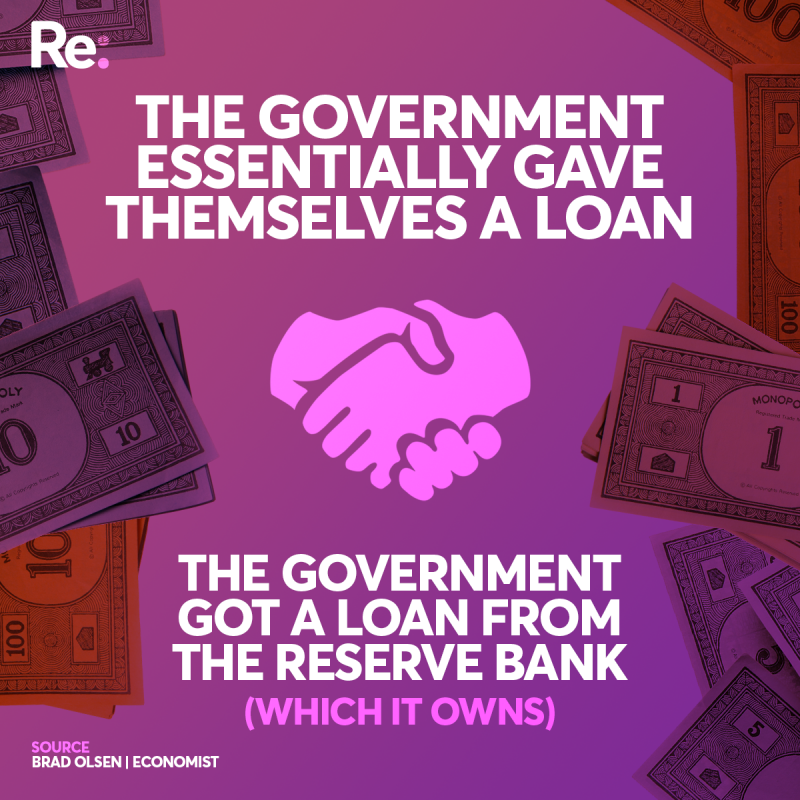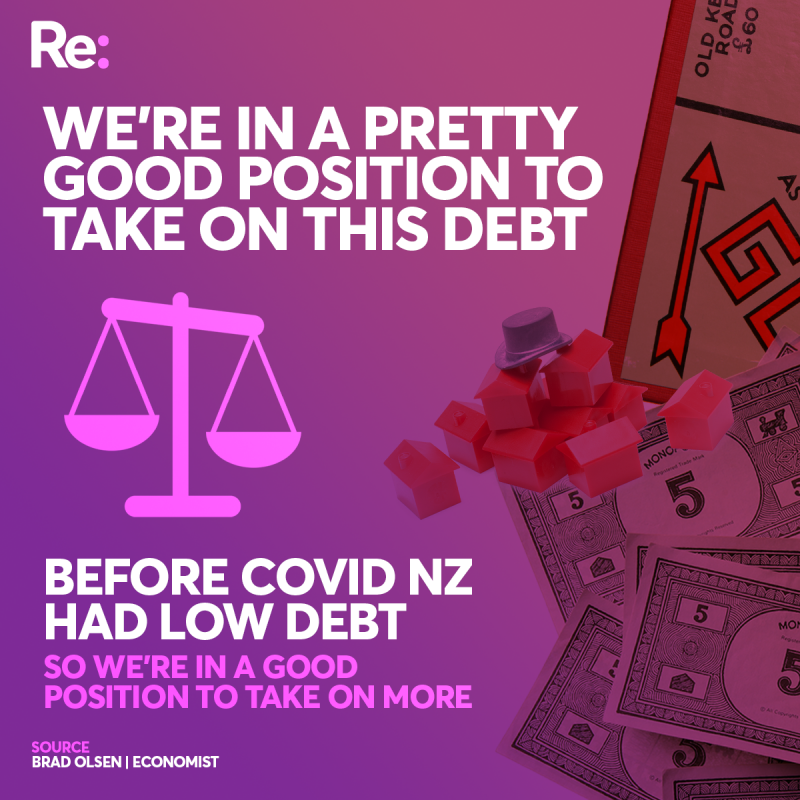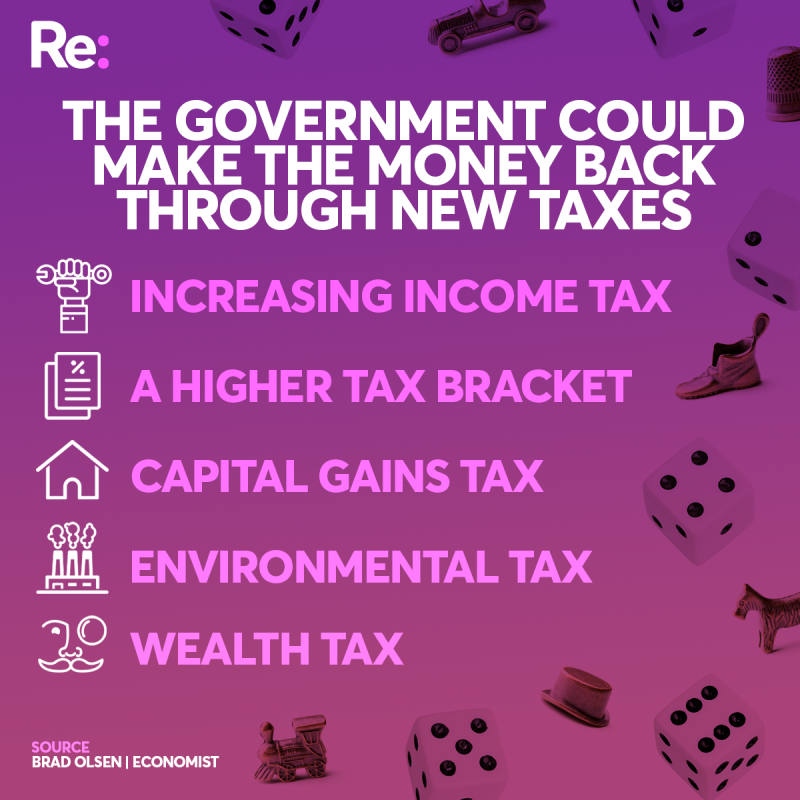Last week the Government announced a $50 billion dollar budget, or as Finance Minister Grant Robertson likes to call it, “The most significant commitment by a New Zealand government in modern history”.
I’m going to be honest with you, finance means nothing to me.
I’m a human interest and pop culture kinda gal, so when it comes to financial stories I scroll on. When I see a political story I barely make it past the headline.
And when you combine both finance and politics, you can guarantee the information will be stored in a filing cabinet inside my head labelled Smile, Nod and Pretend you Know What They’re Saying.
But it’s time to open that cabinet and address some of the questions I’ve been too embarrassed to ask. The first: where the heck did we get $50 billion dollars from?

Brad’s here to explain some finance to us.
Enter Brad Olsen, a senior economist at Infometrics. I asked him to explain it to me in the simplest possible terms. The short answer is: we borrowed it and it will have to be paid back over time with interest.
Brad is the reason I can now use the phrase “debt to GDP ratio” confidently in a sentence, but more on that later.
Here are the key things I have learned:
- The Government essentially gave themselves a loan
- We’re in a pretty good position to take on this debt
- Debt isn’t a dirty word and there are lots of ways to pay it back
Let’s break that all down a bit more.

The government essentially gave themselves a loan
What? Where was this when I needed a loan for a new car? How does it work? The government owns the Reserve Bank, who are basically the big wigs doling out most of the cash. So the government borrowed from a bank they own.
BUT the Reserve Bank is statutorily independent from the government so technically they could say no to lending them money. The reason they don’t is because the government is a dream candidate on paper.
It’s also important to point out that there are other people in the market that lend the government money through bonds alongside the Reserve Bank.
Before going any further, I need to introduce you to the concept of a government bond (and let’s be clear, we’re not talking about a seductive spy who works for MI6).
You can think of a government bond like a slip of paper that the government has signed saying they will pay a lender x amount over x time with x amount of interest. They can be bought by large banks (on what's called the primary market) or by other investors and small banks (called the secondary market).
The Reserve Bank, retail banks and institutional investors buy directly from the government and then on the secondary market the Reserve Bank, retail banks and institutional investors trade them between each other.
Effectively, the government gets a bunch of cash in their bank account which they agree to repay with interest to those who purchased bonds.
“Often we look at the likes of a ten-year bond,” says Brad, “but there are a number of other instruments and essentially at the moment, the people that buy those bonds or the people that give the government its cash in return for that obligation are the likes of institutional investors, retail banks and the Reserve Bank itself.”
How do we even have the capacity to ask for this much more money heading into a recession?
$50 billion is an historic figure for New Zealand, it’s almost twice the amount of last year's budget ($25.6 billion) and let’s face it, times are uncertain.
But Brad says one of the reasons interest rates are low for the government is because people are really confident in the government issuing bonds.
“If you’re a retail banker, you’re saying ‘Do I want to trust this huge amount of money that I’m giving to the government will actually be repaid?’”
The answer to that question at the moment is yes.
“The government can, and does, compel tax to be paid so it comes out of people’s pay slips which means they’re pretty good for it, they’re fine at being able to repay us, we’re confident they’ll repay, so the scale of (the loan) is fine.”

We’re in a pretty good position to take on this debt
Now is the time for you to learn my NEW FAVOURITE PHRASE: Debt to GDP ratio – or in other words, how much money we owe compared to how much money the economy makes.
By increasing our debt and understanding that the economy isn’t going to be doing as well as it usually does, our debt to GDP ratio is projected to grow from roughly 19% pre-Covid to 54% in 2023. Logic dictates you always want to have more money coming in than going out so is this something to panic about?
“In the last few years we have seen a return to surplus,” says Brad.
A surplus is when the government has more money than it spends. For example, it means when they’ve taken more money in taxes than they’ve spent on things like education, roads and health.
A deficit is the opposite - when the government has spent more than it will earn in taxes.
We’ve had surpluses every year since 2015. Last year the surplus was $7.5 billion, and we were projected to have another surplus in 2020, before Covid hit.
Instead, we will have a deficit of $28 billion this year, and $29 billion next year. We’re not likely to get back to a surplus any time in the next decade.
But because of our recent history of surplus, “the government has been able to drive down the amount of debt that New Zealand has held and that is our pandemic insurance,” says Brad. “At the moment we are now spending that pandemic insurance because the rainy day has arrived and we’re now making sure to invest in the country.”
It’s no secret that a second wave of Covid-19 could hit, or another future pandemic we haven’t heard of yet. A very highbrow observation I’ve made of the financial response to Covid is “mo’ problems mo’ money”. We’ve used a lot of cash to keep Aotearoa strong already. I wonder, if we were to get another shock and had to borrow again, will we be at a higher risk level for paying debts back?
If you haven’t noticed, Brad has a gift for keeping things simple. “It certainly wouldn’t be the most fun experience,” he says.
“It would of course increase some of the pressures on the New Zealand government, but because we’re starting with a low debt to GDP ratio anyway, we’re in the best starting position.”
Phew.
“We’re still nowhere near a lot of our international partners – we’re below the likes of the US, we’re below Japan, so we could weather it. It would be a lot more uncomfortable, we’d have to take on a lot more debt, we’d probably have to start paying more for it, but everyone else would too, so in a relative position we would still – I’d expect – be more comfortable than not.”
This prospect is starting to make my stomach churn. I wonder how high can that debt to GDP ratio can go before things start to look dire. Brad makes a couple of international comparisons.
“In Japan’s case they’re currently running at 200% of GDP and everyone wonders when that will ever change. New Zealanders in the last decade or so have focussed on trying to get debt to around 20% net debt to GDP.
“Generally speaking, most economists will say that we could have debt to GDP of around 30% during normal times. We expect that in the short term during a crisis – and let’s be clear, Covid-19 is absolutely a crisis – we can have debt to GDP of around 50% for a wee while.
“We’ve got to remember that other countries around the world are starting off with much higher debt levels. I think the likes of the US started at around 80% debt to GDP and that will rise to over 100% quite quickly. New Zealand is in a very very good place comparatively.”
If things got really bad, could we just be like Japan and live in a perpetual state of paying money back? That’s politely shut down by Brad who says there would be consequences.
“There would come a point where people wouldn’t be as keen to take on a loan from the government – the sheer size of it would make people be a little bit more cautious, a little bit more nervous.
“It would decrease the number of people that are willing to lend to the government and it would also push up the interest rates. So having that low debt to GDP level means we can respond to a crisis and it means that we can respond quickly and at a low cost.”

Debt isn’t a dirty word and there are lots of ways to pay it back
Immediately I assume this debt will be paid back with an increase to my taxes. The alarmist in me says that if taxes increase I’m going to have less money to spend on coffee and artisan bread.
But Brad tells me increasing income tax is not the government’s only option.
“I think we might have to start putting options that we never considered seriously in previous times,” says Brad. “In this new economic environment we do have to put all cards back on the table.”
We could increase taxes or start new ones
Income tax
This is the money that disappears out of my pay before it hits my account.
“You could raise income taxes as we move forward, so people pay more of what they earn from their daily job towards what the government will get from them.”
But it’s not actually likely the government will use this as their first option, according to Brad. Basically, with so many more people now unemployed, the government won’t make that much money by increasing income tax, and it would be very politically unpopular.
Brad says increasing income tax is “certainly going to be hard in the near term as people are trying to make more money and get back into employment.”
A higher tax bracket
New Zealand has a progressive tax system, which means if you earn more money you’re taxed at a higher rate. Currently, these rates are separated into four brackets:
- Up to $14,000: taxed at 10.5%
- $14,000 - 48,000: taxed at 17.5%
- $48,000 - 70,000: taxed at 30%
- $70,000 and up: taxed at 33%
This means that a person earning $70,000 pays exactly the same tax rate as a person earning $400,000.
Brad says one option could be introducing a fifth tax rate that would target the wealthiest people in the country. “You could introduce something that’s like $150 – 200,000 a year to capture some of those slightly higher earning areas.”
Capital gains tax
A capital gains tax is a tax for profit you make off investments - like if you sell a house, or shares.
Currently New Zealand does not have a capital gains tax - meaning people who buy and sell rental properties don’t pay any tax on the profit they make.
Labour campaigned for a capital gains tax but New Zealand First vetoed it, making it impossible for this government to bring one in. In April last year Jacinda Ardern had to concede it was not possible for her to get one through while she was prime minister.
Brad says even though the Prime Minister has ruled a capital gains tax out during her terms of office, we could look to something that is similar to a capital gains tax. “Effectively you’re trying to make money on the gains that investment has and that’s an area that we don’t actually currently tax or tax to the same degree as other forms of income.”
Environmental tax
“That would of course incentivise people to be not quite as intensive on the environment and redistribute where the money is being earned from,” says Brad. “You would tax polluters a lot more and try and capture more of that element in terms of pricing it in, so if you are going to have a higher cost on the environment, you pay for that higher cost you impose.”
Wealth tax
“Not only is it just a tax on income but it’s a tax on your general wealth position – again that can bring in money over time.”
So there’s a range of tax options to bring in more money. But we can also look at how we reduce the amount of money that we spend from a government point of view.
Or we could reduce the amount of money we currently spend
Superannuation
Brad says one option is increasing the age at which you can get superannuation retirement payments from the government.
“When we last set the age of super at 65, people were living at quite a few years fewer than what they currently live now,” he says. “So essentially we might have to consider raising the age of super ... and change some of those eligibility rules there.”
“On the spending side we need to look at what economists term ‘sacred cows’. That is how the New Zealand economy operates, that’s just a given, we’re going to have to challenge some of those assumptions to pay this huge amount of debt we’re taking on.”
It’s important to remember we won’t be the only ones making sacrifices and instead of being intimidated by debt, in some ways we can look at this particular debt as a tool.
“It spreads the cost over a number of years,” Brad explains.
“The classic example is if you build a bridge that is going to last for 50 years, you might want to pay it with debt so you spread the cost of that bridge over that 50 year period.
“If you pay for it all now using your current fund, it means the current pool of taxpayers are having to pay for a bridge even though people who are not yet even born are going to be using it later on down the track.”
Millenials are famous for blaming the boomers for unaffordable housing, but how do we make sure we aren’t doing the same thing to generations to come?
Brad says we need to keep in mind who is paying off this debt down the track. “We need to make sure that when we do make decisions about how we pay this off we understand and recognise who is having to pay this off.
Why can’t we just print more money and get on with it?
Throughout our whole conversation I’ve been saving this question for last because it’s embarrassingly basic.
“To a point that is sort of what we’re doing,” says Brad. “The way that the Reserve Bank creates more money is very close to that and in some respects it is printing money.”
“The reason we can’t do that indefinitely is that for every additional dollar that we effectively have, the dollar that we had already is not worth quite as much. It’s still a dollar, but what it will buy you is effectively becoming less.”
The example Brad uses is that a loaf of bread might cost $5 now but if we start printing too much money, something called hyperinflation happens. All of a sudden the price of bread becomes $2000 because we’ve printed so much money that our entire holdings (all the actual cash we have circulating) is worth less.
But wait, who is driving up the cost of bread? It’s everyone, says Brad.
“The breadmaker put his prices up because the person who provides the flour to them has gone up and so it cycles around the economy,” explains Brad.
“We do have to be careful as we print money that we don’t see those inflation expectations rise significantly because if we do, that is when we start to get that hyperinflation scenario.”
So what will happen?
The conclusion I’ve come to is that New Zealand has enjoyed a relatively stable economy for the past wee while, and a lot of changes are heading our way. The things that need to be filed away in the Wait and See cabinet are how the government will choose to pay back $50 billion dollars plus interest, and how prepared we’ll be if another economic shock were to come.
For now, I leave with a few more financey terms up my sleeve and the knowledge of what hyperinflation might do to the price of my sourdough.